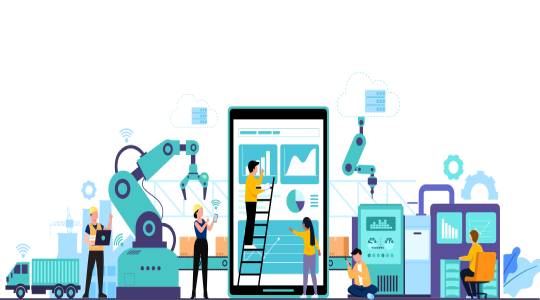The Era of Consumer-Driven Manufacturing Is Here. Are You Prepared?
For a manufacturer to be successful, it is essential to fully align their products and services with fast changing market conditions and consumer demands. Having a holistic view of operations and customer interactions is vital to better meet consumer needs and maximize the value delivered to them. Enabling consumer-driven manufacturing isn’t as easy as it seems. The shift to a customer-centric model requires a strong focus on the transformation of age-old manufacturing processes and their close and continuous alignment with consumer demand.
The rise of consumer-driven manufacturing
Trends in the manufacturing ecosystem are constantly evolving. With IIoT devices flooding the factory floor, digitally powered connected factories are becoming more common. Today manufacturers, irrespective of their size - big and small - are now driving efforts toward Industry 4.0, making substantial improvements in factory structure to constantly increase efficiency at all stages along with optimization of cost while producing quality products and services.
Almost all of these efforts are directed and driven by consumers. With intense competition, it has become extremely important for manufacturers to gain a competitive edge over its competitors. Meeting customer needs and staying ahead of the race requires manufacturers to follow an agile and flexible manufacturing approach. Transforming the manufacturing processes and strategy that enables agility, flexibility, and adaptability will be key for consumer driven manufacturing.
Simultaneously, as more and more consumers become environmentally conscious, companies also need to work towards improving their sustainability stance and invest in technologies that allow them to minimize their carbon footprint. Manufacturers are equally stressed about meeting strict time-to-market deadlines, as more and more companies offer 1-day or even same-day deliveries.
Preparing for the new era
In the digital age, just adjusting your product strategy isn’t enough to meet customer needs. To survive and succeed, you need to put your customers at the center of every business decision you make. Since today’s customers expect personalization and superior experience throughout the buying journey, regardless of the channel or device they use. Tailoring unique experiences for them across all of your channels and touchpoints requires you to have a deep understanding of their preferences, inclinations, and budget.
Increasing adoption of digital technologies - such as IoT, AI & ML, data analytics, robotics, augmented reality (AR), and virtual reality (VR) are playing a big role towards the transformation to a consumer-driven manufacturing approach. However, legacy systems, siloed teams, and the over-reliance on manual labor poses a huge threat in meeting customer expectations consistently. Since legacy systems are often poorly integrated, manufacturers have a tough time achieving a single source of truth, which eventually impacts the products and experiences they offer to their customers. To effectively drive value, you need to take several steps and make several adjustments to your business model, including:
- Improving enterprise visibility: Meeting the evolving needs of consumers requires you to have enhanced visibility into manufacturing operations. The lack of visibility can result in little or no insight into emerging risks, the operating conditions of the shop floor, the health of machines, inefficiencies of processes, etc. It is important to invest in tools and technologies that provide real-time visibility into the entire manufacturing landscape.
- Breaking silos: Relying on multiple siloed data sets (aka Excel sheets) due to poor integration between the many manufacturing systems can restrict your ability to respond to customer needs with quality and speed. If you want to establish and maintain updated records and logs of customer needs, you need to integrate the disparate systems having different control mechanisms and having multiple communication protocols and break departmental silos for better collaboration and communication of goals, risks, and opportunities.
- Modernizing systems: Legacy systems can restrict your ability to drive innovation. Therefore, to keep pace with customer demands, it is important to modernize your legacy systems and resolve problems across inefficient maintenance, poor integration, and restricted predictive maintenance. Investing in advanced systems can deliver the capabilities and performance needed to enhance process efficiency, improve visibility, and accelerate time-to-market.
- Proactively tracking OEE: Tracking OEE is important to ensure high availability, performance, and quality of processes and products. Engaging in proactive quality control and automating the monitoring of equipment can reduce wastage and rework. It can also enhance the overall efficiency of the plant through better asset maintenance. At the same time, predictive maintenance can enable visibility of asset health while optimizing them for better availability, utilization, and performance – allowing you to keep up with your sustainability goals.
- Enabling remote monitoring: Surviving in the era of consumer-driven manufacturing also requires you to enable remote monitoring of assets and processes. With manufacturing units now expanding across geographical boundaries, such real-time remote monitoring can help in collecting and harmonizing data from different equipment, PLCs, and SCADA systems and building intuitive OEE dashboards for improved offline and online condition analysis of machine cycles. In the long run, such analysis can lead to optimization of scheduling the manufacturing operations better aligned with consumer needs.
Keeping up with the pace of consumer-driven manufacturing and enabling holistic consumer-centric customer experiences is top of mind for every manufacturer today. But preparing yourself for this new era of manufacturing requires a lot more than just a wider product portfolio. To understand customer needs and exceed their expectations, a complete overhaul of the manufacturing setup is needed, which includes improving enterprise visibility, breaking silos, modernizing systems, proactive tracking of OEE, and enabling remote monitoring.
Taking these steps can allow you to enhance customer satisfaction. It can also help drive innovation faster and enhance the impact your efforts have on tangible business value.



